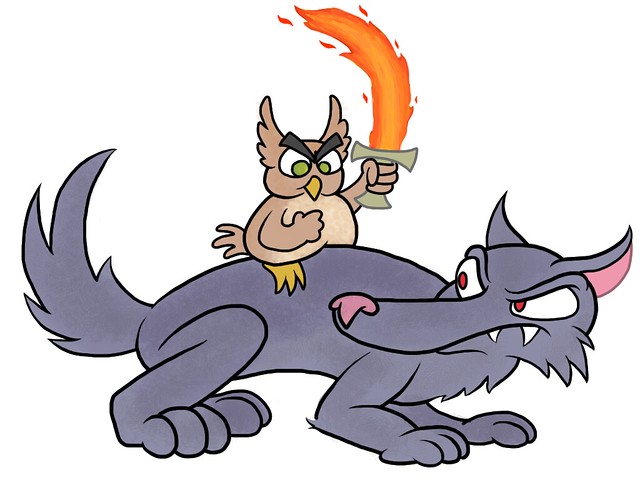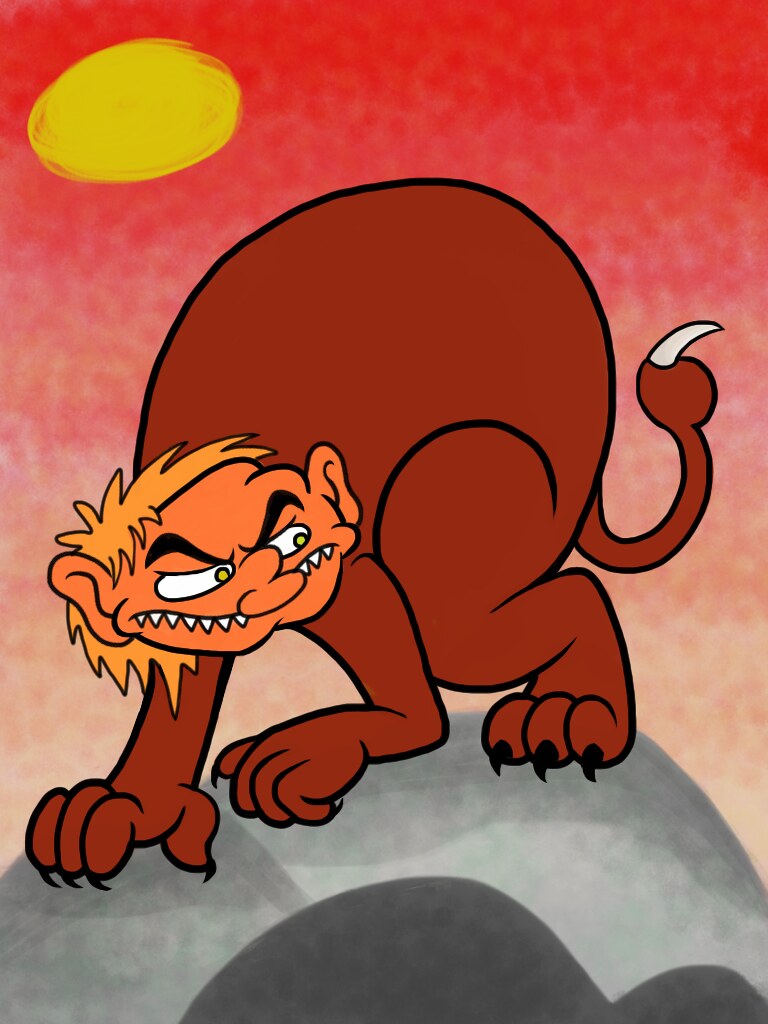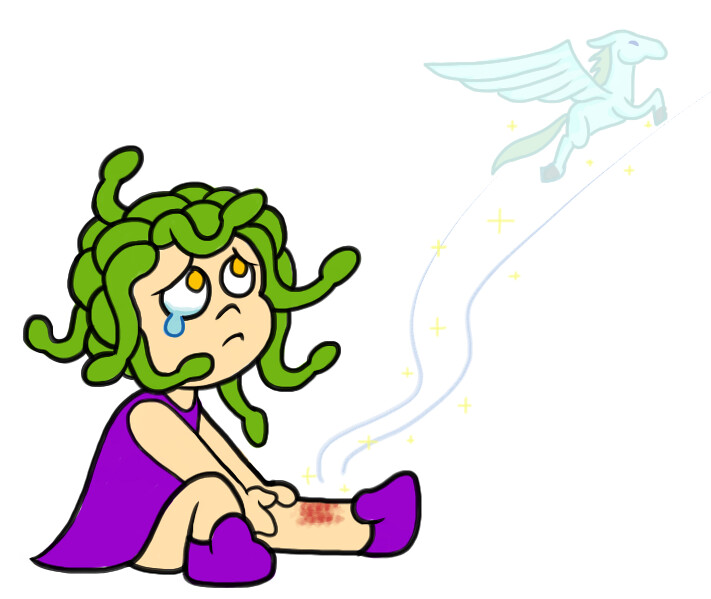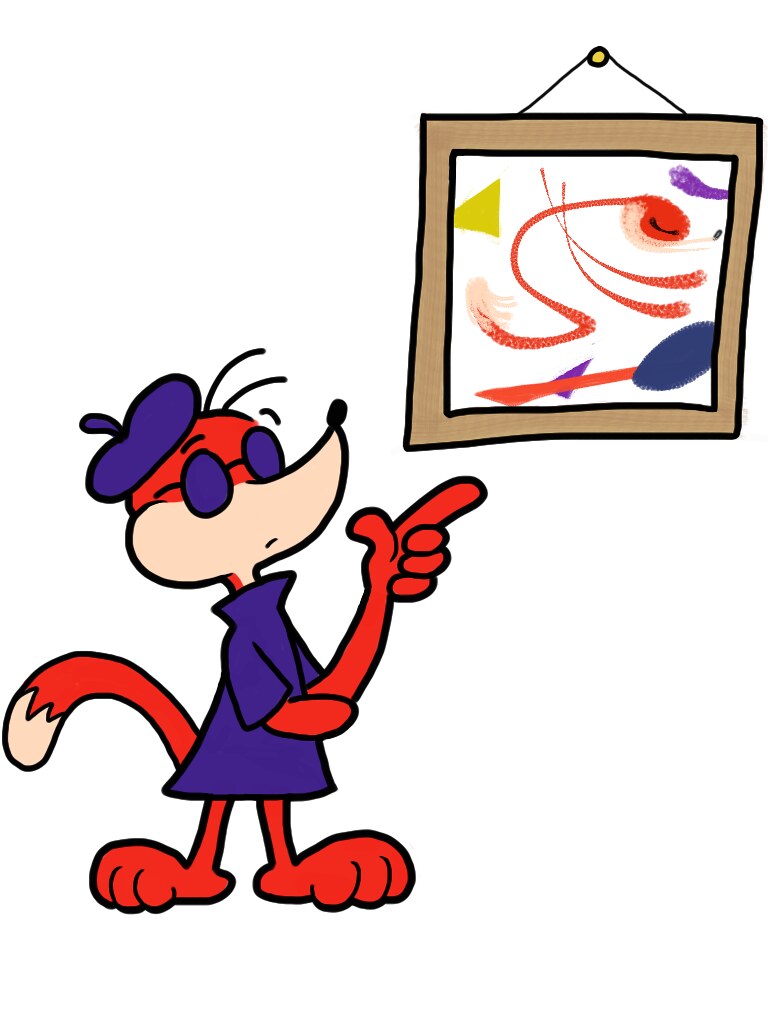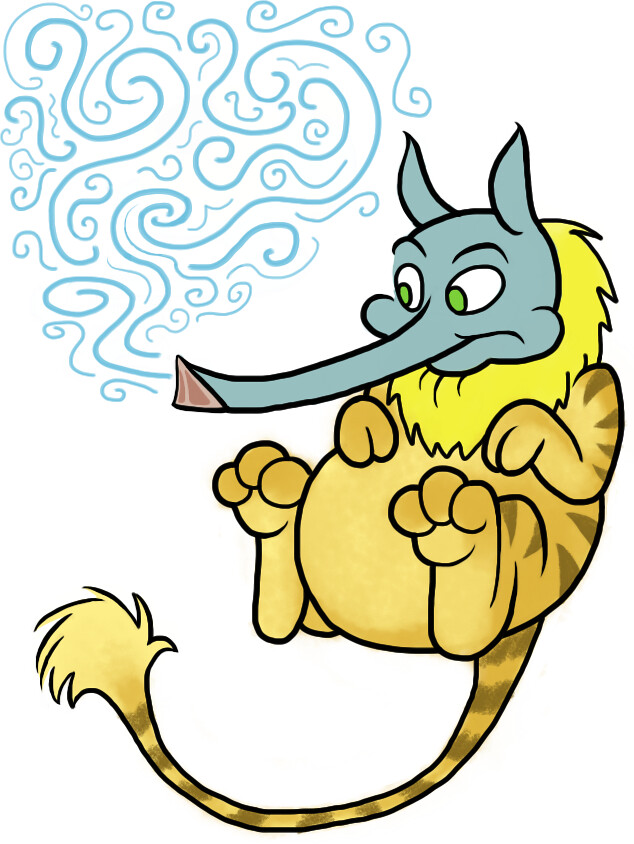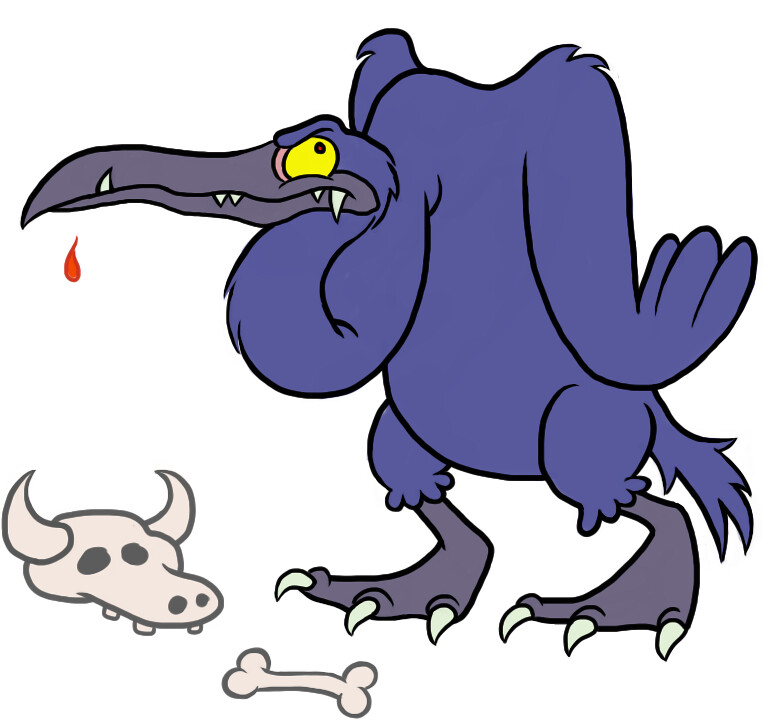Wednesday, February 23, 2011
Wednesday Doodle: Bucky and Clione
I think I may need to rethink my updating schedule. Wednesdays are ridiculously busy for me right now. Its a good thing I had this doodle to ink over and slap some color on. Maybe I'll give Thursday a try next week instead...
Bucky you know, but this is the first the blog has seen of Clione. Clione is one of the characters who will be starring in the eventually forthcoming Bucky and Friends comics. She's a sea snail, specifically an anthropomorphic version of the sea angel family. Sea Angels are predatory snails that live in icy waters. Their feet muscles evolved into distinct wing-like flaps giving them a fairy-like appearance. In case you're wondering what happened to their shells, they actually do have them at birth but discard them early in their life cycle. That's the reason the order's scientific name is Gymnosomata, or "naked body" in Greek.
They are voracious hunters, devouring snails and sea butterflies with deadly tentacles that pop out of the top of their heads. See that red blob in Clione's head? That's her digestive system.
Monday, February 21, 2011
Andras
Goetia refers to the practice of invoking or evoking angels and demons. Today it most commonly refers to a specific grimoire known as The Lesser Key of Solomon, a 17th century text containing a catalog of spirits, both divine and demonic, that the legendary King Solomon had bound to serve humanity if summoned properly. The Goetia is a gold mine of fun monsters.
This cute little fellow is Andras, the Grand Marquis of Hell, the Killer of Men and the 63rd demon in the Lesser Key of Solomon. Andras is described as an owl, or a man with an owl head, riding atop a massive wolf. He wields a sharp flaming sword which he uses to sow discord (as well as the more conventional cutting and burning things).
Andras may not look like it, but he's one of the most dangerous demons a magician can summon. If the conjurer and his assistants to follow the Solomon's instructions exactly, he will kill them without a moment's hesitation. A single misstep out of the magic circle means the death of the magician, and Andras knows this. Andras reviles those who control him and will use any trick he can think of to lure them into dropping their defenses. Summoning him means a constant battle to maintain control.
Like all of the demons bound into servitude by Solomon, he is summoned to teach the magician some secret knowledge. As you might guess, Andras specializes in teaching magicians how to kill their enemies more effectively. He could also evoke an uncontrollable anger in people, useful for a magician who wants to incite a war or make an opponent careless. He commands 30 legions of demons and spirits in Hell, which he uses to spread dissent and chaos between people.
Saturday, February 19, 2011
Xenicibis
Xenicibis was discovered in Jamaica in 1977 by Storrs Olson. Its bone structure was so strange that Olson thought it must've had some kind of bone disease. In fact, the bird had extremely powerful weighted ends on its wings. Obviously, these wings were not very useful for flight, but they may have been especially useful for bashing predatory snakes or even monkeys and birds of prey. The size and weight of these wings means that xenicibis might have walked on them like crutches. If not use for defense, it may have been used in mock battles with members of its own species for territory or mates.
The bones that make up the clubs are hollow, like a baseball bat. This means they could dish out real damage without being too heavy to wield. The long "handle" at the joints meant that it could be swung very quickly and had a very far reach. Whether it was used to bash rivals or bash predators, it would have been quite a formidable weapon.
Non-ibis related: I've been thinking about how I want to update this blog, and I think its best if I do so on a consistent schedule. So from now on I will be updating with new drawings every Monday, Wednesday and Saturday.
Monday, February 14, 2011
Saturday, February 12, 2011
Thursday, February 10, 2011
Manticore
Meet the manticore, one of the classic bogey-men of antiquity. Manticores are originally from Persian legend, but quickly spread throughout Europe after they were mentioned in numerous Greek writings on natural history. Described as a massive red lion with the face of a man, the manticore was often blamed for people going missing. It devoured men whole, grinding them up with its three rows of teeth. Escape was difficult, as the beast had a deadly poisonous stinger on its tail and sometimes the ability to fire poisonous spines.
Throughout the Middle Ages, copies of such Greek works as Pliny the Elder's Naturalis Historia made the manticore and other monsters popular in heraldry and bestiaries. The original Persian legend had gone through so many translations and mistranslations that there were a number of different offshoots. Some bestiaries described it as being a male equivalent of the sphinx. Some more skeptical works identified it as a tiger. Some were intelligent, some were simple beasts, some were even musical, but nearly all were deadly.
Throughout the Middle Ages, copies of such Greek works as Pliny the Elder's Naturalis Historia made the manticore and other monsters popular in heraldry and bestiaries. The original Persian legend had gone through so many translations and mistranslations that there were a number of different offshoots. Some bestiaries described it as being a male equivalent of the sphinx. Some more skeptical works identified it as a tiger. Some were intelligent, some were simple beasts, some were even musical, but nearly all were deadly.
Wednesday, February 9, 2011
Tuesday, February 8, 2011
Monday, February 7, 2011
Mid-Monday Doodle: Bucky T. Weasel, self portrait
I'm working on some more drawings for mythology, paleontology and zoology posts this week, so in the mean time I'm going to upload some drawings I made when I was first testing out Brushes on my iPad. The line work isn't as polished as my more recent stuff, but its better than no updates at all.
I've come up with a LOT of original characters over the years. Detective Mummy, Nate and Wendy: Monster Rehabilitators, Bahiti the daughter of the Sphinx, the Incredible Edible Planet of the Clams, Templeton the clockwork salamander knight, and on and on. Most of them never got finished stories, but I like to "check in" on them from time to time, drawing some sketches to see how they've changed and what they've been up to since I last thought about them.
This character, Bucky, is one I've been drawing at least since fourth grade. Being a character I've drawn for so long, he's gone through many changes. Sometimes he's been more Looney Tunesian, sometimes lankier and more influenced by newspaper comics like Pogo or Calvin and Hobbes, sometimes he's been grungier and based more on the underground comics I used to trick my parents into letting me buy as a kid. There was that ill-advised period where I wanted to draw him "anime" in high school and then shortly after was when I learned what a furry was and I made him a human for awhile. My first attempt at doing a webcomic starred Bucky. Then in college I realized that I shouldn't try to shoehorn any characters into every story just because I'd been drawing them for a long time. Bucky slipped into the retirement, occasionally popping up as a doodle when I wanted to test out a new pen, but without any real plans or stories of his own.
I figure in all that time he's been keeping busy, reaching some of the same conclusions about his role in art as I did, and now he's finally comfortable with himself as a hip beatnik. He's someone who cares about art and about himself and is extremely confident as long as he doesn't stop talking or working to think about it. Once he does stop to think or reflect, that's when all the options and possibilities and doubts of the world creep into his mind. To his friends he may come across as narcissistic and flighty, but single-mindedly diving into an idea is just part of how he gets through life. I remember as a kid watching a PBS cartoon about a girl who had to recruit an army of weasels to help defeat an evil army of basilisks, but they were too timid and flighty unless they had gotten hepped up on a magic weed. This idea sort of inspired my idea of Bucky's personality. When I start uploading comics to this blog, some of them will definitely star Bucky and his friends in Carl Barks/Osamu Tezuka-style comedy/adventure stories.
Deciding what to draw in his self portrait was hard at first. I don't do much abstract art but I didn't want to end up overthinking it (which I'm sure anyone reading this will agree is something I do very often). Then I realized that Bucky isn't really a great artist, he just thinks he is and loves the process more than the result. He's not someone who would be able to plan a composition effectively. At his best he would be able to start one, but then invariably get distracted and muddle things. The question became "ok, so what kind of mistakes would he make in a painting?" and was a lot easier to come up with ideas. Then I decided I was overthinking it after all and finished up.
I've come up with a LOT of original characters over the years. Detective Mummy, Nate and Wendy: Monster Rehabilitators, Bahiti the daughter of the Sphinx, the Incredible Edible Planet of the Clams, Templeton the clockwork salamander knight, and on and on. Most of them never got finished stories, but I like to "check in" on them from time to time, drawing some sketches to see how they've changed and what they've been up to since I last thought about them.
This character, Bucky, is one I've been drawing at least since fourth grade. Being a character I've drawn for so long, he's gone through many changes. Sometimes he's been more Looney Tunesian, sometimes lankier and more influenced by newspaper comics like Pogo or Calvin and Hobbes, sometimes he's been grungier and based more on the underground comics I used to trick my parents into letting me buy as a kid. There was that ill-advised period where I wanted to draw him "anime" in high school and then shortly after was when I learned what a furry was and I made him a human for awhile. My first attempt at doing a webcomic starred Bucky. Then in college I realized that I shouldn't try to shoehorn any characters into every story just because I'd been drawing them for a long time. Bucky slipped into the retirement, occasionally popping up as a doodle when I wanted to test out a new pen, but without any real plans or stories of his own.
I figure in all that time he's been keeping busy, reaching some of the same conclusions about his role in art as I did, and now he's finally comfortable with himself as a hip beatnik. He's someone who cares about art and about himself and is extremely confident as long as he doesn't stop talking or working to think about it. Once he does stop to think or reflect, that's when all the options and possibilities and doubts of the world creep into his mind. To his friends he may come across as narcissistic and flighty, but single-mindedly diving into an idea is just part of how he gets through life. I remember as a kid watching a PBS cartoon about a girl who had to recruit an army of weasels to help defeat an evil army of basilisks, but they were too timid and flighty unless they had gotten hepped up on a magic weed. This idea sort of inspired my idea of Bucky's personality. When I start uploading comics to this blog, some of them will definitely star Bucky and his friends in Carl Barks/Osamu Tezuka-style comedy/adventure stories.
Deciding what to draw in his self portrait was hard at first. I don't do much abstract art but I didn't want to end up overthinking it (which I'm sure anyone reading this will agree is something I do very often). Then I realized that Bucky isn't really a great artist, he just thinks he is and loves the process more than the result. He's not someone who would be able to plan a composition effectively. At his best he would be able to start one, but then invariably get distracted and muddle things. The question became "ok, so what kind of mistakes would he make in a painting?" and was a lot easier to come up with ideas. Then I decided I was overthinking it after all and finished up.
Saturday, February 5, 2011
Baku
Today we have the baku, one of my personal favorite monsters from Japan. I've always liked chimerical monsters, they're always so interesting looking and fun to draw. Plus baku look great either as ferocious or as adorable. Today I've gone with adorable.
The baku is a dream-eating monster that devours nightmares and is therefore often beneficial to mankind. Because of this ability, baku were depicted on amulets to protect against nightmares or other sleep problems. Sleepers could even invoke a baku to come and protect them. Like many famous Japanese monsters, it is thought to have originated in Chinese folklore. The baku has been depicted in Japan since the Muromachi period (1336 to 1573). In ancient times it was usually depicted as a ferocious creature with sharp claws, huge tusks and glaring eyes. This appearance helped scare off demons and spirits that brought bad dreams. Of course, the idea of a monster that devoured dreams wasn't only used for feel-good happy stories. There are a few tales of baku that devoured all kinds of dreams, not just nightmares, leaving the poor sleeper restless and mad.
The classical baku is described as looking like a cross between an elephant and a tiger/lion. Today the elephant aspect (or indeed, the entire creature) is instead depicted as a tapir. Why the change? Well baku is also the Japanese word for tapir. The Chinese and Korean names for tapir also correspond to their forms of the legendary baku. Presumably, Asian zoologists thought that the Malaysian tapir's famous proboscis and its 50/50 split coloration was reminiscent of the legendary chimera. Japanese children were taught about the baku by their parents as a playful bedtime story. Young Japanese people growing up in the 20th century grew up hearing both uses of the word, and of course many of them went on to become filmmakers, artists or writers. The baku is, alongside the kappa, tanuki and tengu, one of the most common Japanese monsters to appear in modern pop culture, and so eventually the tapir-baku became the dominant archetype.
For an interesting non-traditional baku, I suggest checking out Satoshi Koh's excellent movie Paprika.
Thursday, February 3, 2011
Boobrie
The boobrie is a sinister water bird of Scottish folklore, said to resemble a gigantic loon or stork. The boobrie's diet is mainly carnivorous, with a particular fondness for the flesh of young calves. These are sneaky birds, and their method of hunting is actually quite ingenious by monster standards. The Scottish moors are home to any number of horrific man-eating beasts and so most farmers are well acquainted with the warning signs and methods of escaping any supernatural threat. When a boobrie spots a ship carrying young livestock down the river, it will rush at the ship roaring madly and transforming itself into a well known man-eater such as the each uisge (a horribly evil water horse) or the targh-uisge (an equally dangerous aquatic bull). When the farmers see such an infamous creature rushing at their ship, they assume it is after them and panic, often abandoning ship. While everyone prepares to escape the oncoming threat, the boobrie quickly changes back to its true form, grabs a calf in its beak, and dives into the water to feast.
While the boobrie prefers to hunt calves most of all, in times of need they will hunt adult cows, sheep, otters or occasionally human. For the most part, however, travelers in Scottland don't need to worry about boobrie attack unless they are attempting to transport livestock.
Tuesday, February 1, 2011
Purple Frogs
Today we're moving away from extinct animals and on to an animal is very much alive. For now. Meet the purple frog.
The purple frog is the only surviving member of its ancient family. These frogs lived alongside the dinosaurs 70 million years ago, but today can only be found on a tiny spot of Western Ghats, India where they spend most of their lives underground. They only emerge during the monsoon season.
As you can see, the purple frog is a tiny, goofy, bloated sack of fat with a tiny head and protruding nose. I fell in love with these silly looking living fossils and so I decided to sketch out a few different ways of drawing them in cartoon form. They just have such a lovable, un-frog-like old man face. I colored my favorites above.
Sadly, the purple frog is one of many amphibians currently at risk of extinction. Their habitat is being destroyed for cultivation. Thankfully, Edge of Existence, to whom I linked above, is currently working on a number of projects both to further research of this remarkable species and to help farmers find ways to co-exist with it.
For more pictures of this awesome frog, check out this gallery.
Subscribe to:
Posts (Atom)

